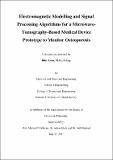| dc.contributor.advisor | O’Halloran, Martin | |
| dc.contributor.advisor | Elahi, Adnan | |
| dc.contributor.advisor | Shahzad, Atif | |
| dc.contributor.author | Amin, Bilal | |
| dc.date.accessioned | 2022-03-14T11:10:59Z | |
| dc.date.available | 2022-03-14T11:10:59Z | |
| dc.date.issued | 2021-12-12 | |
| dc.identifier.uri | http://hdl.handle.net/10379/17036 | |
| dc.description.abstract | Osteoporosis, characterised as low bone mass, causes continuous systematic deterioration of the trabecular bone structure and leads to bone fragility and fractures. Current clinical practices widely employ dual-energy X-ray absorptiometry (DXA) to measure bone mineral density (BMD), which is considered to be the key clinical indicator of osteoporosis. However, DXA is not a portable device, moreover, due to the cumulative effect of repeated X-ray doses used for monitoring osteoporosis over time, the DXA scan may pose long-term health risks. Therefore, there is a need for a portable and non-ionising imaging modality for osteoporosis monitoring. Studies have reported that demineralisation of bones may also result in the change of dielectric properties of bones. Therefore, dielectric properties measurement technology may be employed for monitoring osteoporosis. Microwave imaging (MWI) can measure dielectric properties and exploit dielectric contrast between healthy and diseased tissues for diagnosis or disease monitoring. However, no previous study has reported dielectric contrast between healthy and diseased bones. While several studies have characterised the dielectric properties of both animal and human bones, no data on the dielectric properties of human diseased bones is available. Moreover, despite significant research on bone dielectric properties, no definite relationship between BMD and bone dielectric properties could be derived from the current literature. Regardless, two previous studies attempted to utilise bone dielectric properties and demonstrate proof-of-concept of MWI to monitor osteoporosis. However, no prototype MWI device for osteoporosis monitoring has been previously reported. Neither bone phantoms nor MWI algorithms have been specifically developed for osteoporosis monitoring.
The literature review suggested that variations exist in the dielectric properties of bone reported across different studies. The relationship between bone dielectric properties and different mineralisation levels was found to be inconsistent. Further, it was found that none of the studies have investigated and compared the dielectric properties of healthy and diseased human bones. To this end, this thesis has made the first attempt to characterise the dielectric properties of diseased (osteoporotic bones) and healthy (osteoarthritis bones) human trabecular bones. The availability of healthy human trabecular bones for ex vivo dielectric characterisation is scarce, therefore, this thesis has used osteoarthritis bones as a surrogate to healthy bone samples because osteoarthritis patients have compact and dense trabecular bone microarchitecture compared to osteoporotic patients. The findings of this study showed that there exists a significant dielectric contrast between osteoporotic and osteoarthritis bones. The difference in dielectric properties of osteoporotic and osteoarthritis bones can be exploited using MWI to monitor osteoporosis. The development of the MWI system requires knowledge of a feasible frequency band, determining the dielectric contrast of tissues present in the human heel, and electric field (E-field) penetration in trabecular bone. The parameters (feasible frequency band, matching medium, and numerical modelling of bone) found in this study were used during the development of an MWI prototype for monitoring osteoporosis. To assess and determine the spatial distribution of dielectric properties of the numerical and experimental bone phantoms, a microwave tomography (MWT)-based imaging algorithm was developed. Firstly, the MWT algorithm was used to reconstruct the dielectric properties of diverse numerical bone phantoms under different noise levels. The numerical bone phantoms were developed based on the dielectric properties of osteoporotic and osteoarthritis bones reported in this thesis. The simulation results showed that osteoporotic and osteoarthritis bones can be differentiated based on the reconstructed dielectric properties even for low values of the signal-to-noise ratio (SNR). To evaluate the robustness of the adopted MWT approach for the reconstruction of dielectric properties under practical imaging scenarios, a simplified two-layered calcaneus bone phantom was developed along with a corresponding MWI prototype. The reconstruction of dielectric properties of bone phantoms has shown that the developed MWT algorithm provides a robust reconstruction of diverse bone phantoms with acceptable accuracy. Moreover, the osteoporotic and osteoarthritis bone phantoms were distinguished based on reconstructed dielectric properties. The findings have shown that this two-layered 3-D printed human calcaneus bone phantom and the imaging prototype can be used as a valuable test platform for pre-clinical assessment of calcaneus bone imaging for bone health monitoring. | en_IE |
| dc.publisher | NUI Galway | |
| dc.rights | Attribution-NonCommercial-NoDerivs 3.0 Ireland | |
| dc.rights | CC BY-NC-ND 3.0 IE | |
| dc.rights.uri | https://creativecommons.org/licenses/by-nc-nd/3.0/ie/ | |
| dc.rights.uri | https://creativecommons.org/licenses/by-nc-nd/3.0/ie/ | |
| dc.subject | Electromagnetic Modelling | en_IE |
| dc.subject | Signal Processing Algorithms | en_IE |
| dc.subject | Microwave-Tomography | en_IE |
| dc.subject | Medical Device Prototype | en_IE |
| dc.subject | Bone Health | en_IE |
| dc.subject | Science and Engineering | en_IE |
| dc.subject | Engineering | en_IE |
| dc.subject | Electrical and Electronic Engineering | en_IE |
| dc.title | Electromagnetic modelling and signal processing algorithms for a microwave-tomography-based medical device prototype to monitor osteoporosis | en_IE |
| dc.type | Thesis | en |
| dc.contributor.funder | Horizon 2020 | en_IE |
| dc.local.note | Bilal Amin received his PhD in Electrical and Electronics Engineering from the National University of Ireland Galway. He did his BS in 2013, securing First Class, in Electrical Engineering from COMSATS University Lahore, Pakistan under the auspices of the National ICT scholarship program. In 2015, he earned his Master’s degree with distinction, in Electrical Engineering from COMSATS University Islamabad, Pakistan. His current research interests are compressive sampling, microwave imaging, medical signal processing, dielectric metrology, bone health monitoring, and electromagnetic medical systems. | en_IE |
| dc.local.final | Yes | en_IE |
| dcterms.project | info:eu-repo/grantAgreement/EC/H2020::ERC::ERC-STG/637780/EU/Frontier Research on the Dielectric Properties of Biological Tissue/BIOELECPRO | en_IE |
| nui.item.downloads | 163 | |


